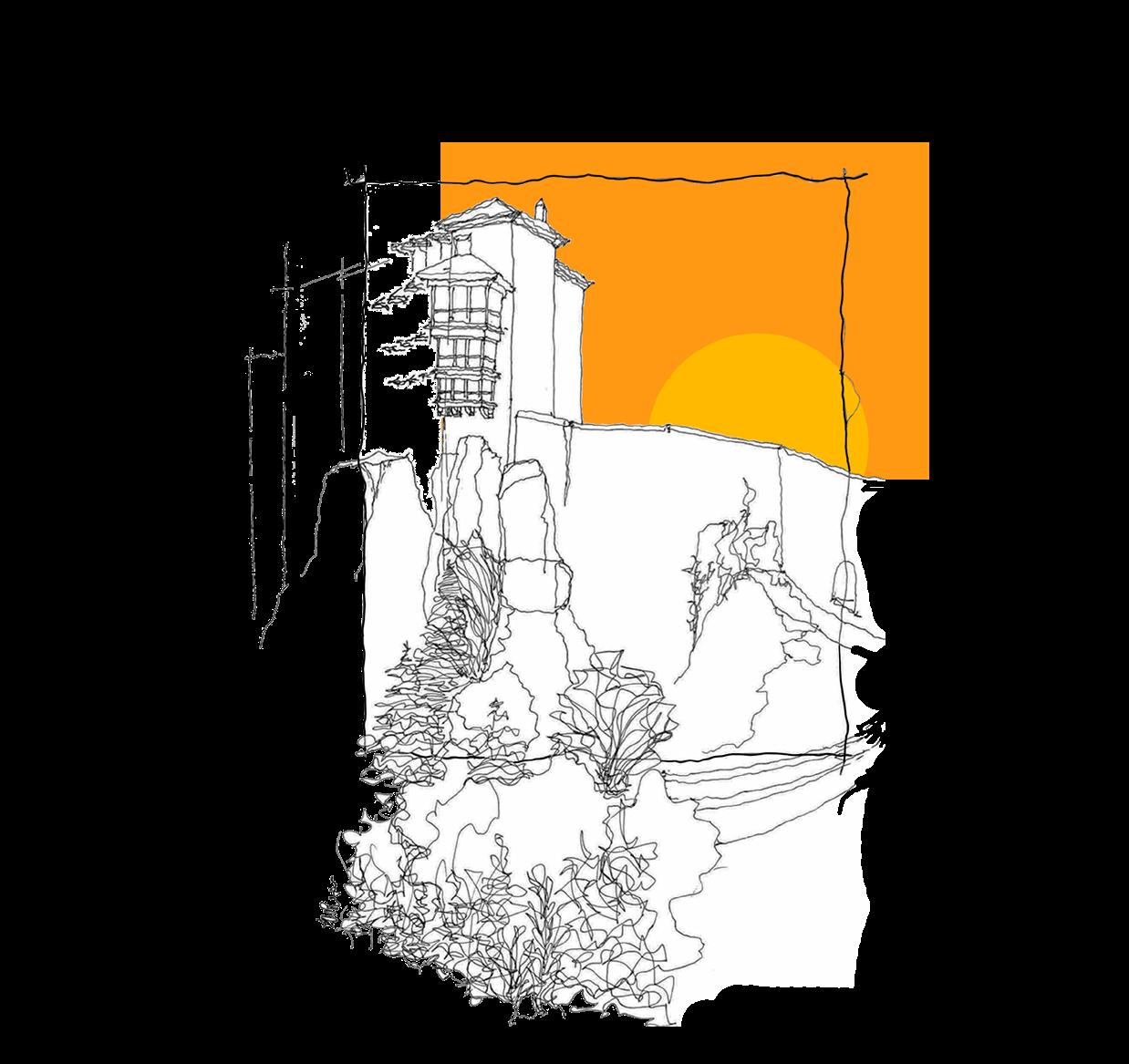
Architecture
Portfolio
3a Reference-Making: Polyforms
Found Objects: Analyses, Collages, Hand-Made Models 3b WOWWAI Campus at Virginia Tech








3a Reference-Making: Polyforms
Found Objects: Analyses, Collages, Hand-Made Models 3b WOWWAI Campus at Virginia Tech






Education & Exploration Through Stitch Studies
Wooden templates and learning exercises offered a starting point for understanding sewing not just as craft, but as a system of spatial thinking. These stitch studies developed coordination between hand, needle, and eye while revisiting foundational design concepts—orientation, density, boundary, hierarchy, layering, joining—through material experimentation, with significant architectural parallels.
These templates, like sites, imposed a logic (Diagram 1) whose constraints enabled or limited different designs. Front and back views of the samples revealed a tension between the implicit and explicit: the back (or underlying structure) could suggest, but never exactly reflect, the design on the front, and identical backs could express entirely different fronts. Adapted templates explored how different elements, or fabrics, of the project met: edge to edge, face to face, ground to wall to roof to sky. Even the practices of mending and upcycling resonated with adaptive reuse strategies.
These exercises introduced me to the craft, reinforced the thesis’s broader interest in design and representation through alternative making, and offered an adaptable method to test material, structural, spatial, and formal relationships.
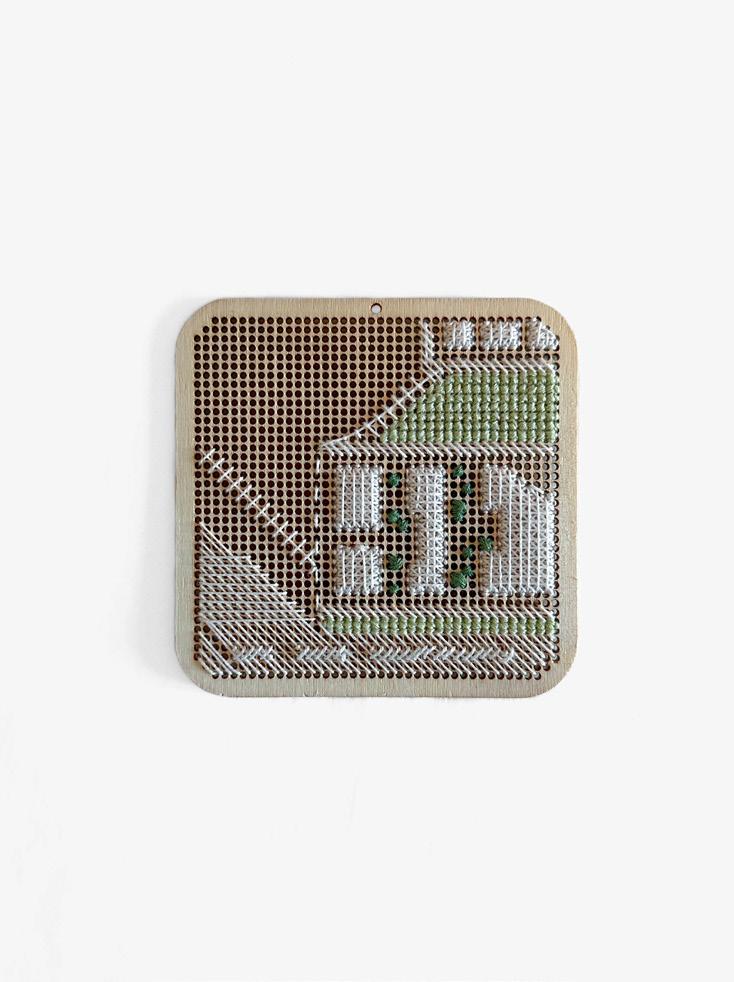


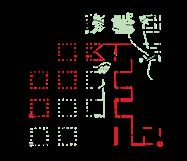
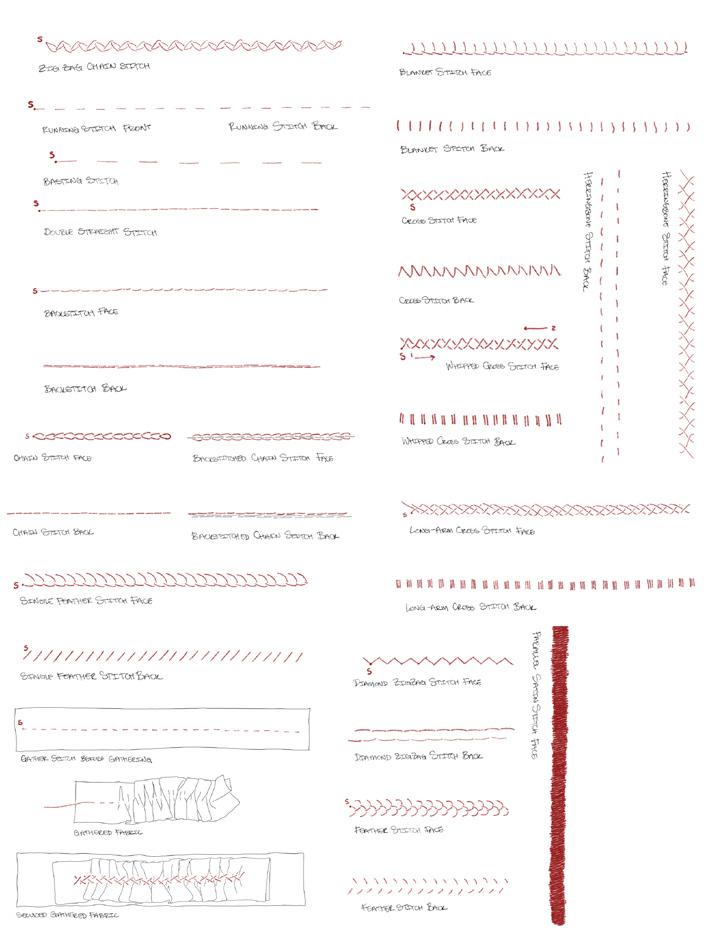




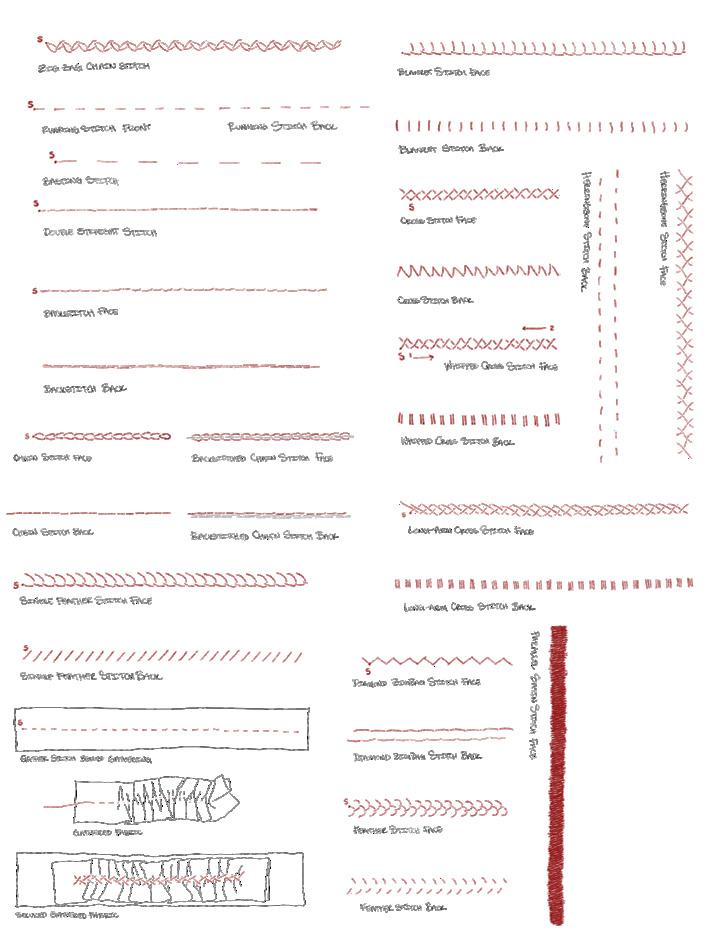


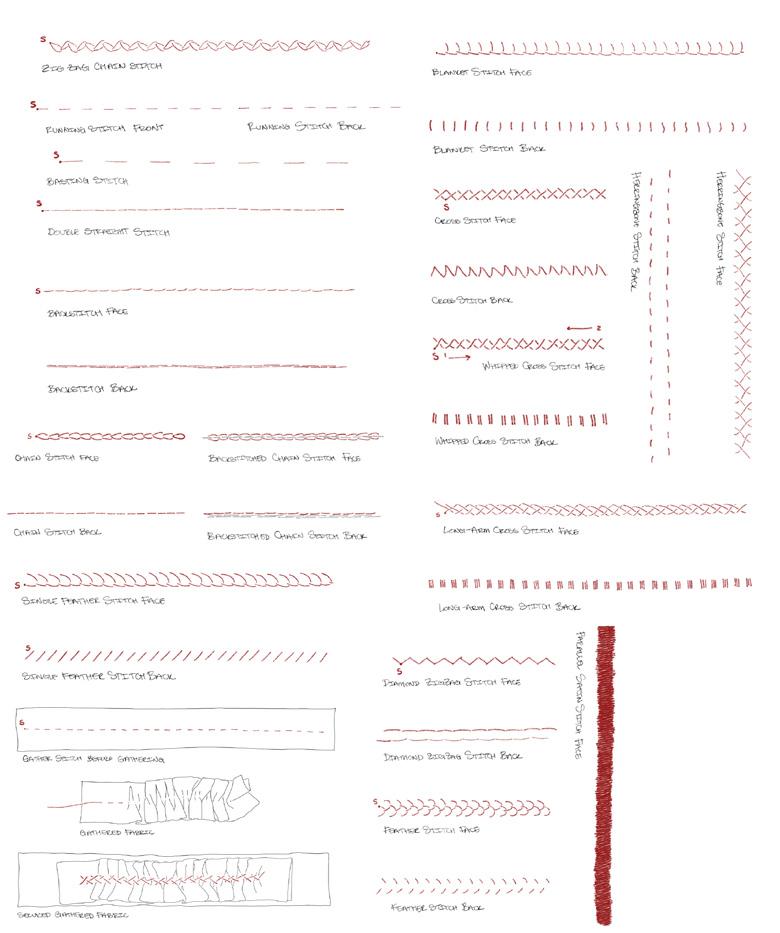



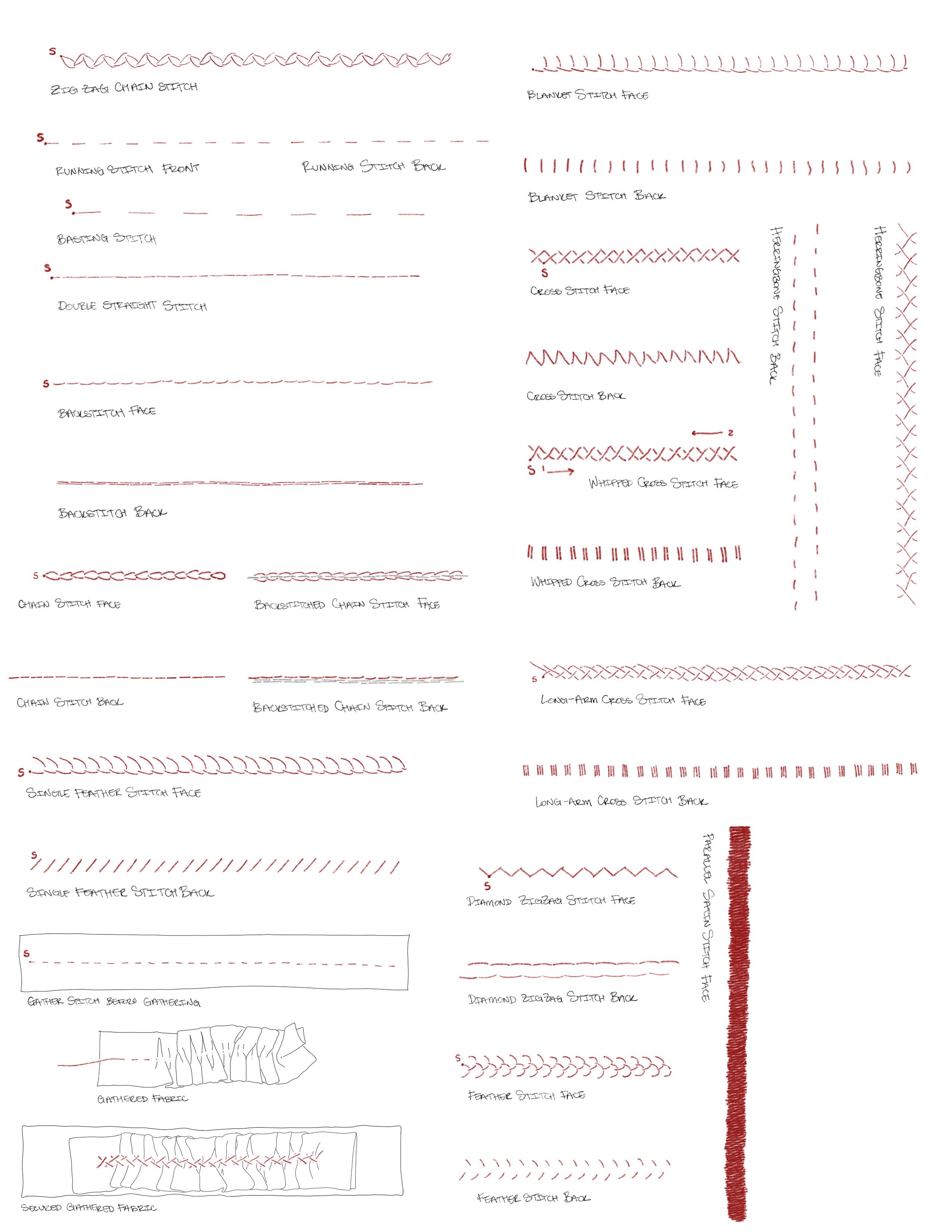
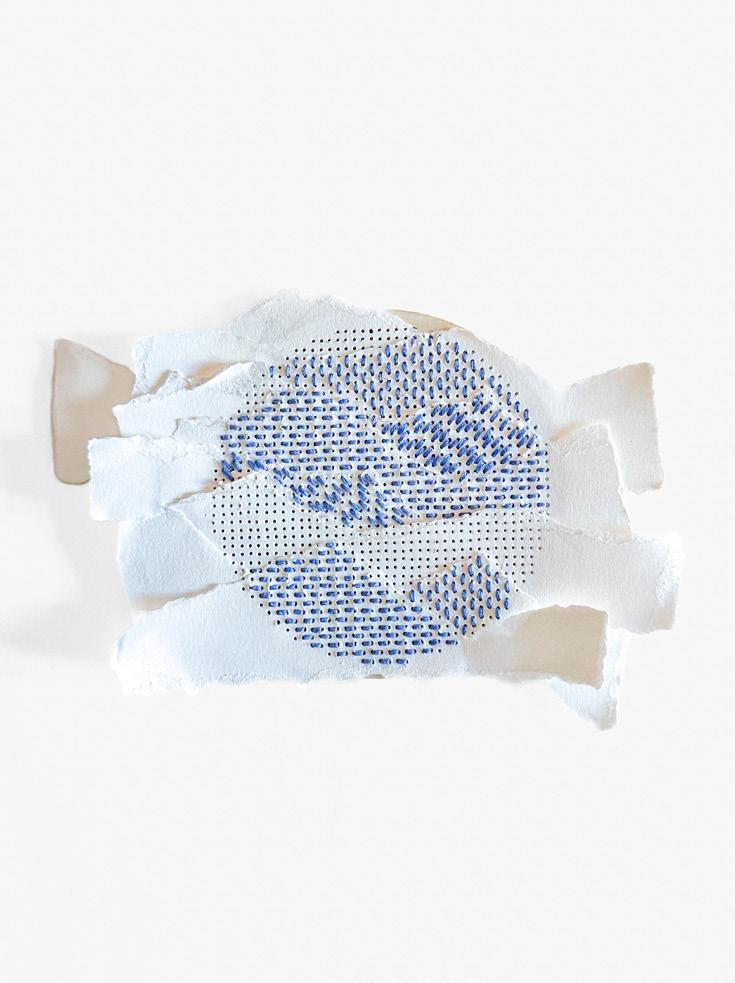

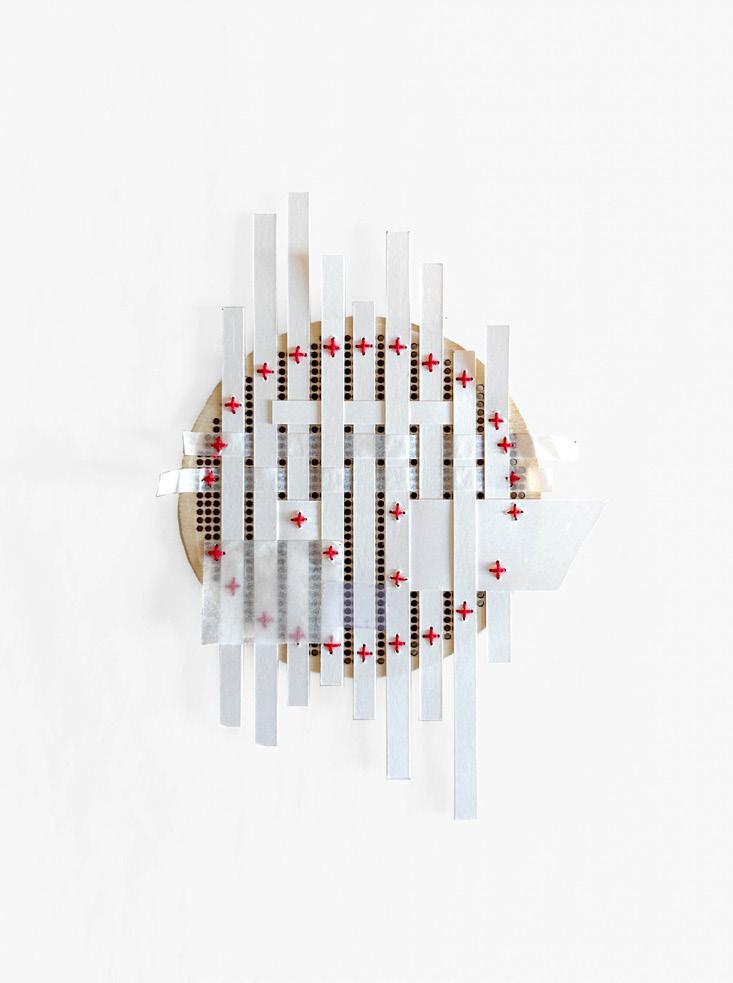

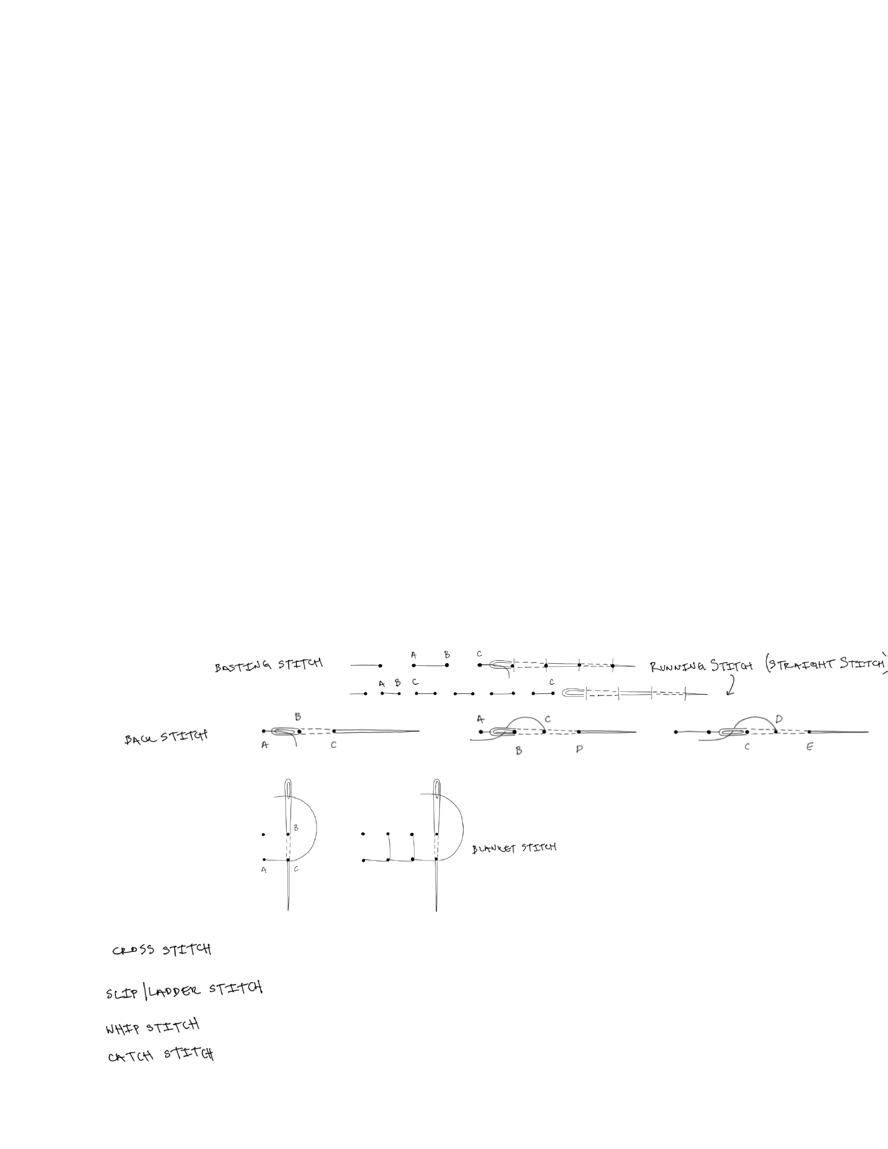




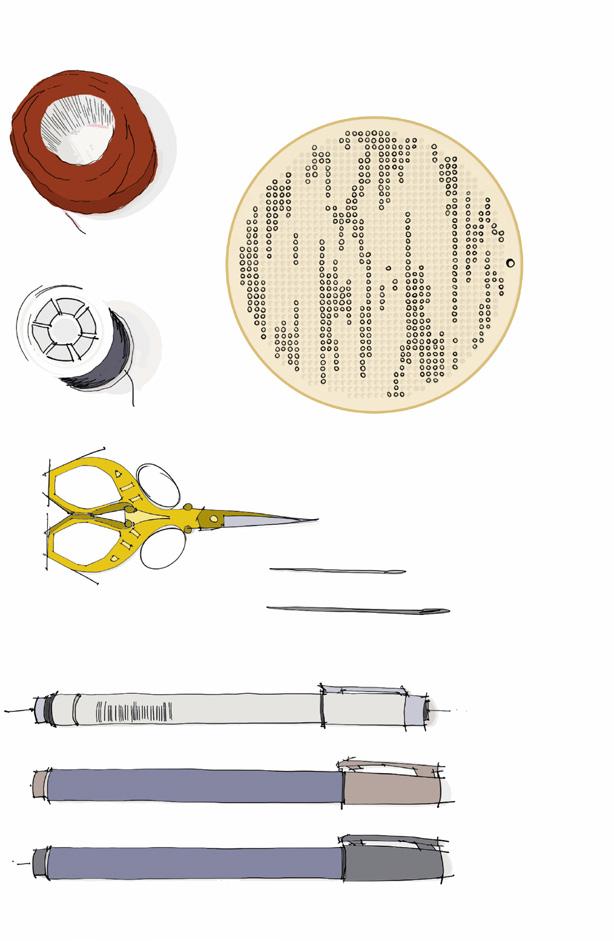


Each sample grouping of natives was developed to ensure year-round structure and presence, with something always in leaf, bloom, or fruit. These resilient species improve soil health, erosion control, and ecological connectivity. They serve as larval hosts, nectar sources, bird habitat, and living infrastructure—inviting both human and nonhuman inhabitants to occupy the garden.



Chain Stitch
Adds texture and ornament using a series of looped stitches. This material marks areas with biking amenities and heavy bike circulation.
Parallel Satin Stitch
A filler stitch composed of tightly-packed parallel lines creating a satin-like finish. This horizontal wood plank marks the ‘back porch’ overlooking the community gardens, receiving and buffering the end of the trail.
Cross Stitch
An elongated version of the cross stitch, used for filling larger areas. This curved and sloped metal slotted surface guides cyclists toward the storage area for bicycles and other gear. This platform wraps around the cafe to the ‘front porch’, rejoining the pedestrian walkway.
Catch Stitch

Slip Stitch

Secures hems or linings with a flexible, sightly stretchy seam. Notice the gapping between platform and building -- a tolerance allowing vegetation to fill the gap between the existing architecture and the proposed interventions.
Whip Stitch


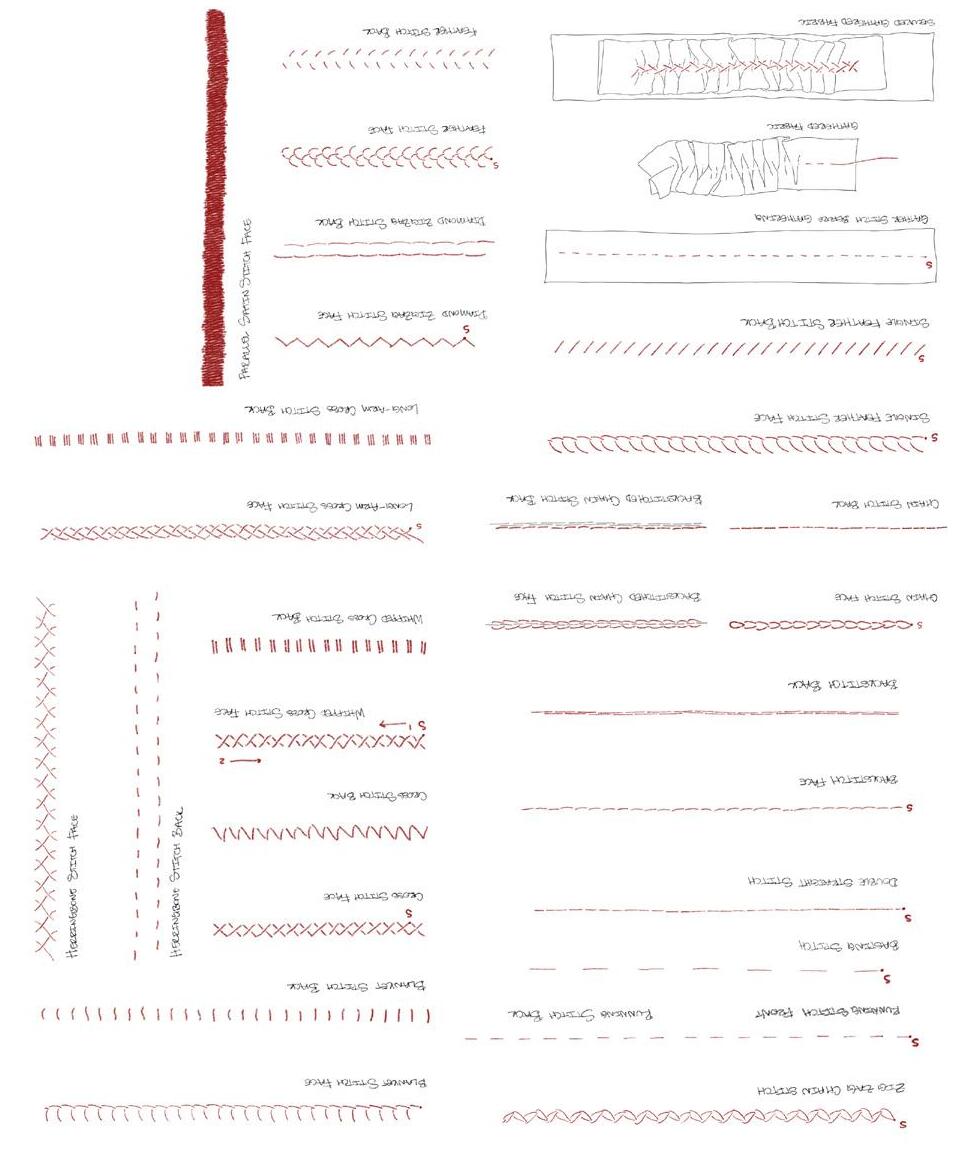
Used for invisible hems or closing seams where stitches need to be hidden. Concealing the vertical transition from station-height to ground level into the building creates an intermediary third space that not only overlooks the garden, but engages it.
A visible diagonal stitch joining two fabric edges or finishing them to prevent fraying. Stark changes in material and orientation mark the threshold where the trail and trailhead circulation officially merge.
Chain Stitch
Combines backstitch and chain stich for additional texture and decoration. Much like the elevated forest walkway, the layering of this chain stitch variation adds a depth and contrast to the underlying forest fabric, piercing it as infrequently as possible while adding circulation to the parking areas at the roadside market.


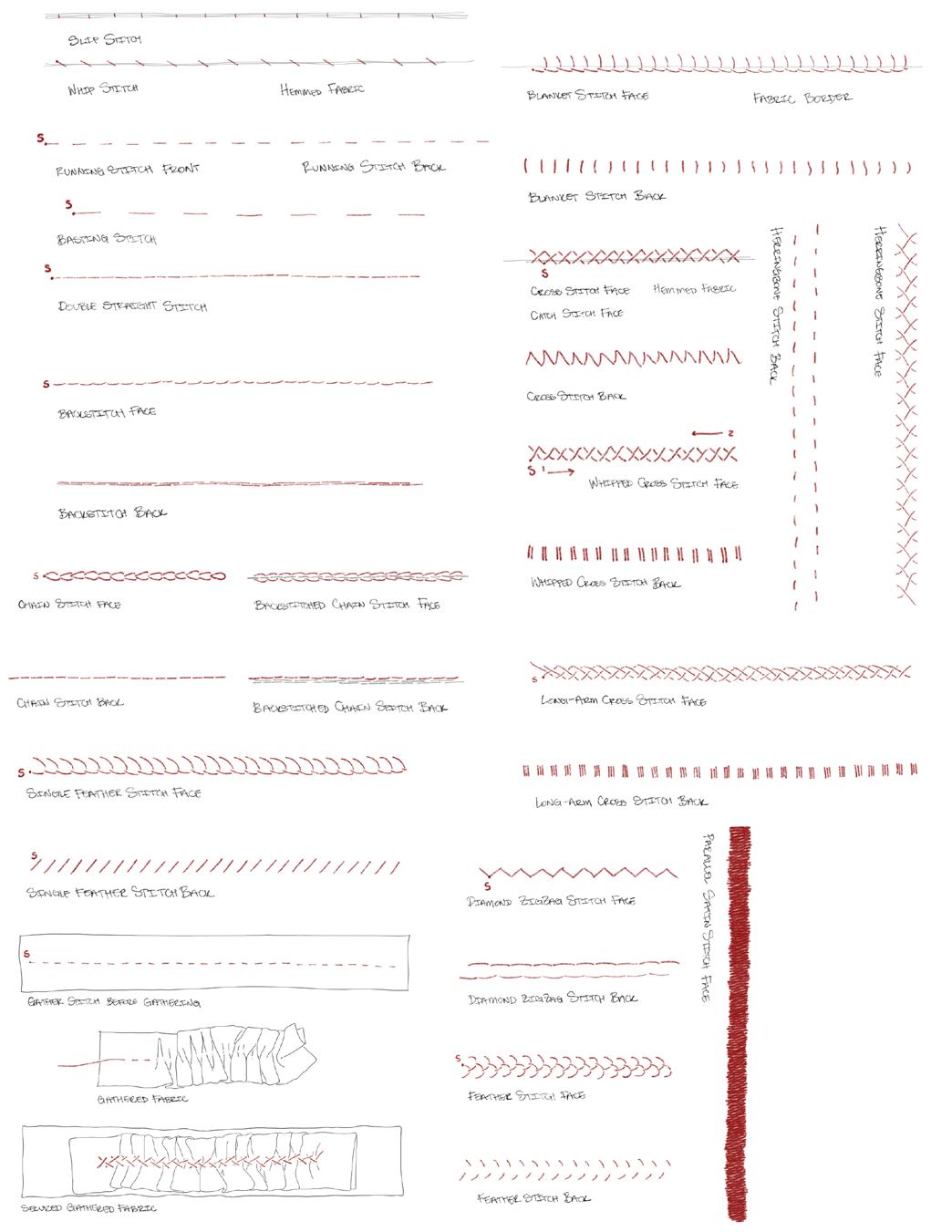

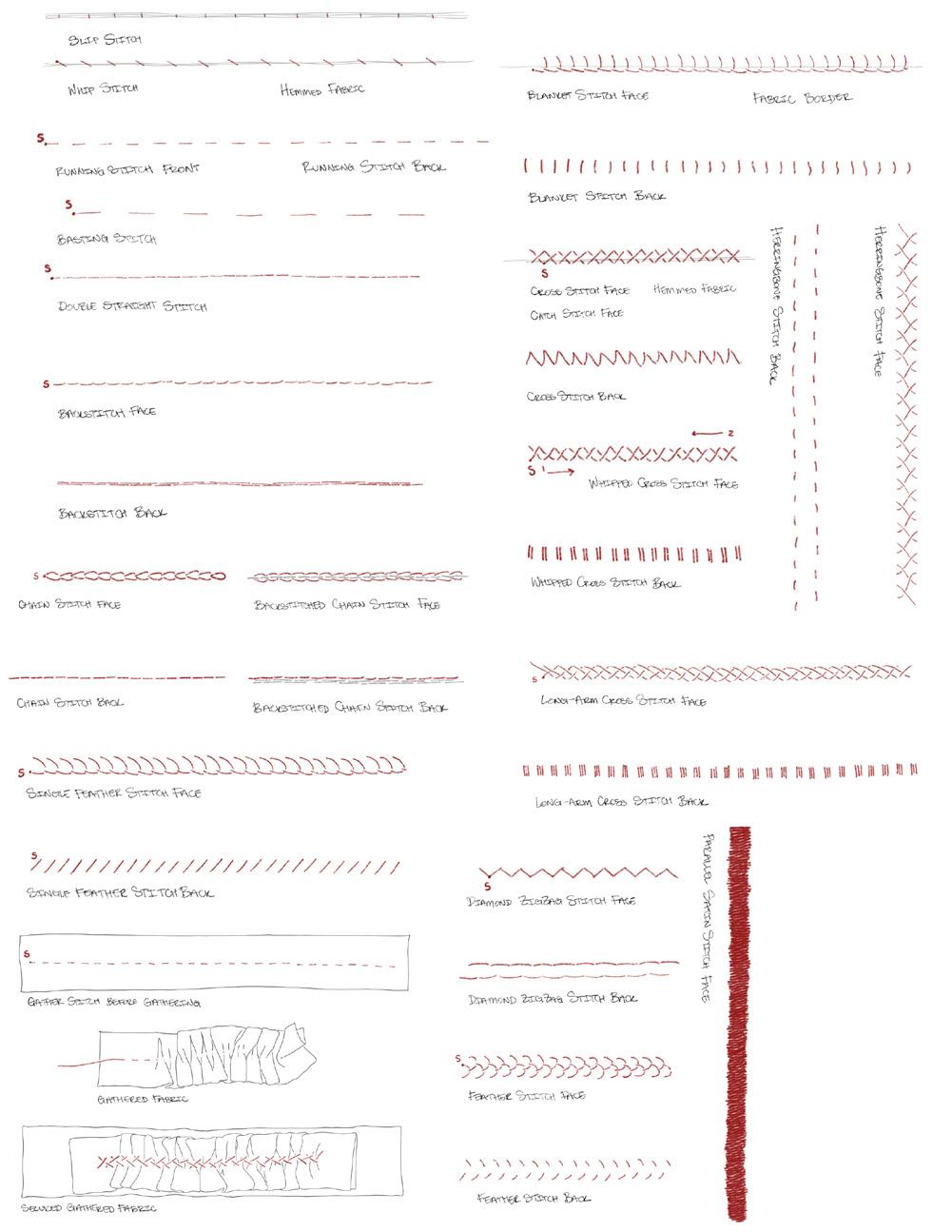
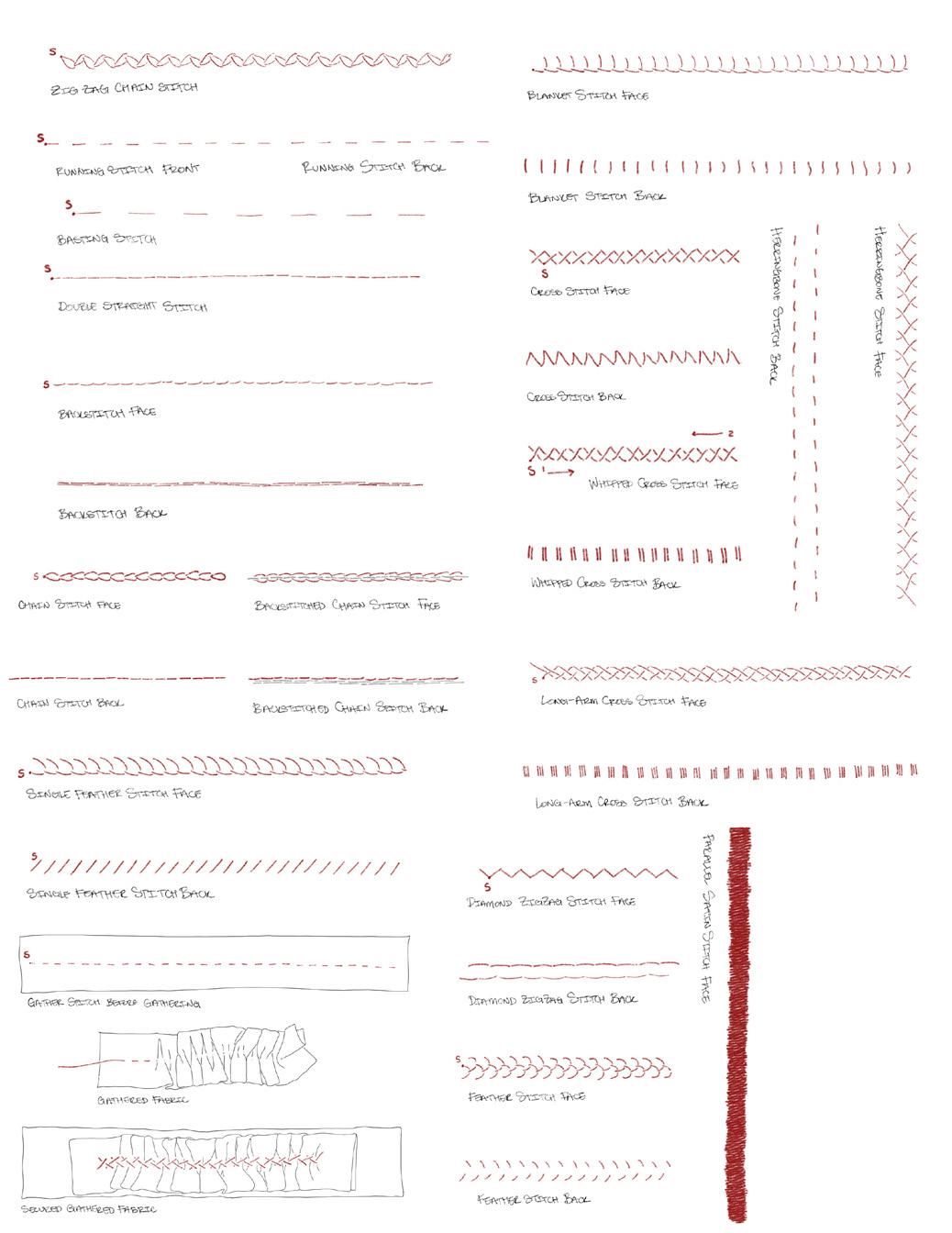


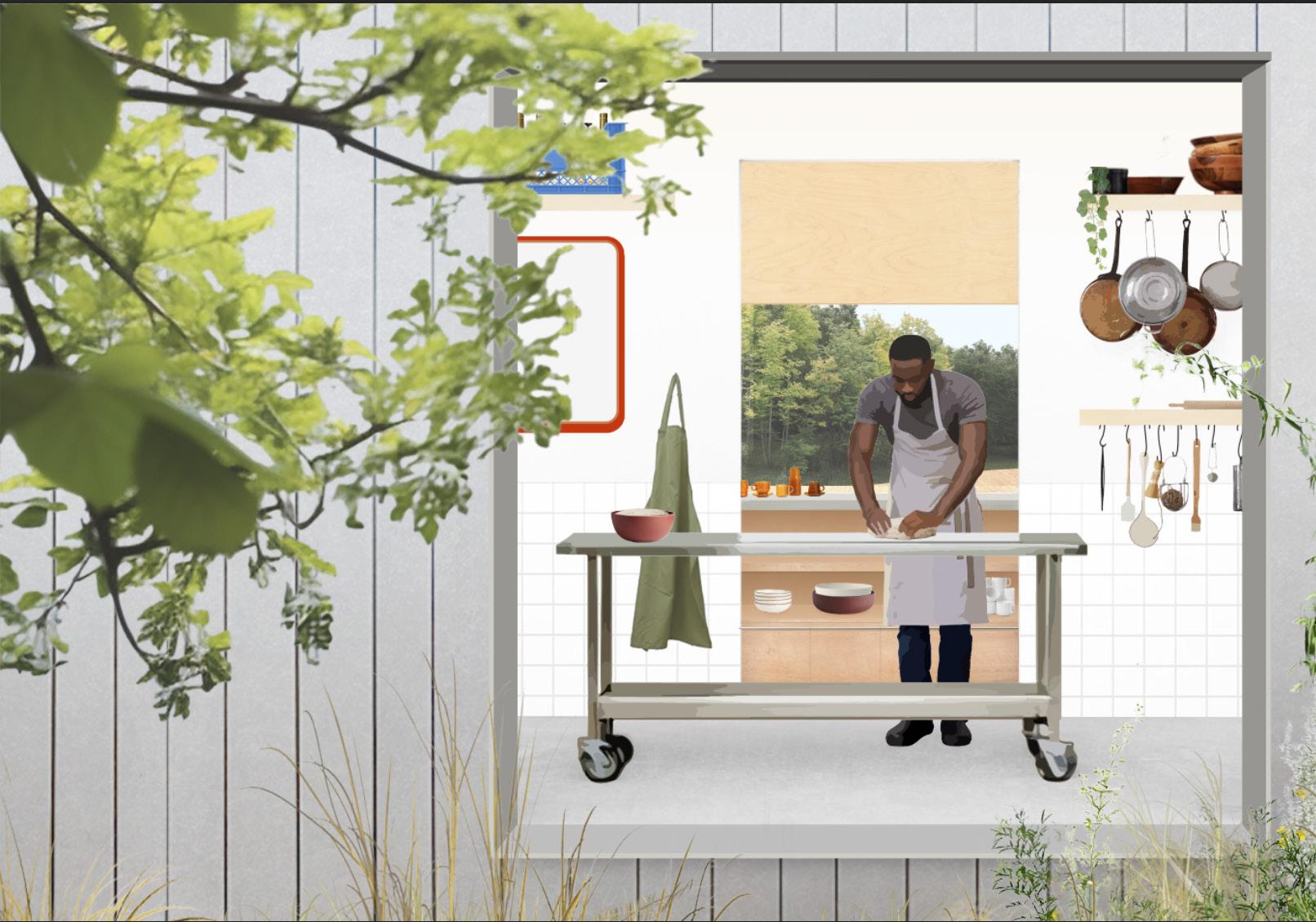


These collage hybrids expand on representational techniques developed in earlier projects while drawing from the layered visual language central to the thesis. Hand-built collages using tracepaper, thread, and printed assets informed the design qualities and ‘staging’ of each scene. The collages also inspired the station’s artwork, including a deconstructed tapestry referencing historic local industry and a sculptural trail map inspired by surrounding rail infrastructure.
The elevations below belong to a series of templatebased folded models. Through cutouts, folds, and material interruptions, this model explores questions of continuity and identity common to adaptive reuse projects. Its faces reflect the buildings’ functions, their spatial relationship, and site circulation.








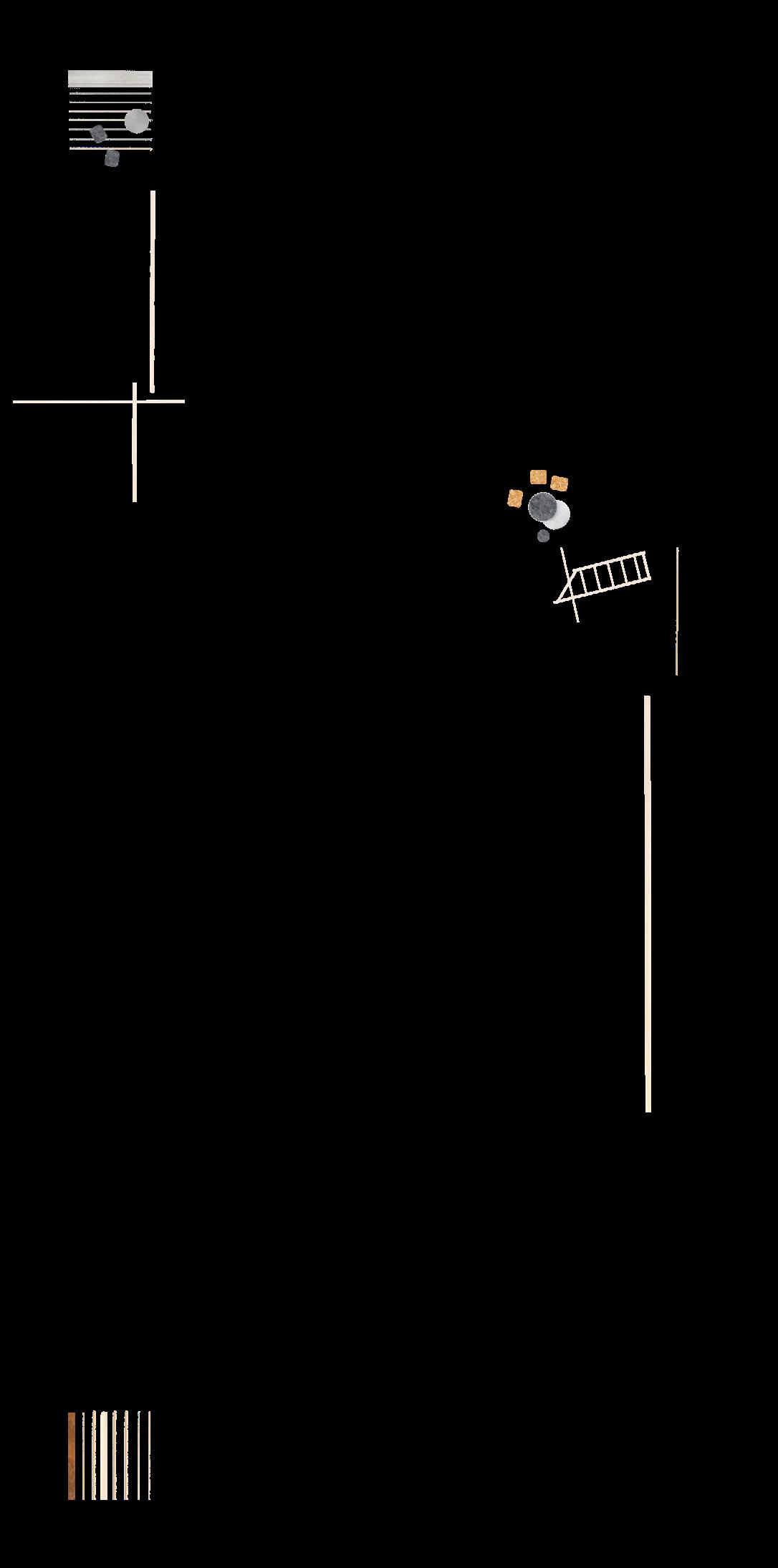


Cross-section of a Thesis
Self-imposed weekly charettes on 14”x17” trace explored everything from the Pamplin City site, to the trailside restrooms and horse trailer parking at the Rochelle trail stop, to an outlandish mega-staircase-museum located inside the historic stone bases of the old Appomattox High Bridge, à la Castelvecchio. This amounted to satisfying piles of sketches, notes, photographs, model templates, collages, felt, and other scraps. Together, they traced the evolution of this craft-driven project: observe, design, test, pause, reengage, repeat.
In that vein, I included a handful of post-thesis redesign sketches that came from stepping back, recognizing the design’s shortcomings, and reentering the work with a clearer, more casual, more curious perspective. This page serves as a reminder that iteration is not just a phase in the design process—it is a practice.






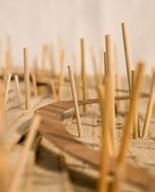


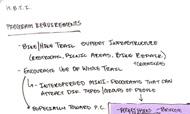

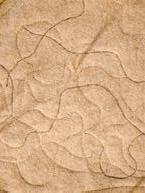
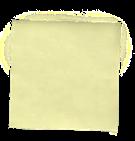











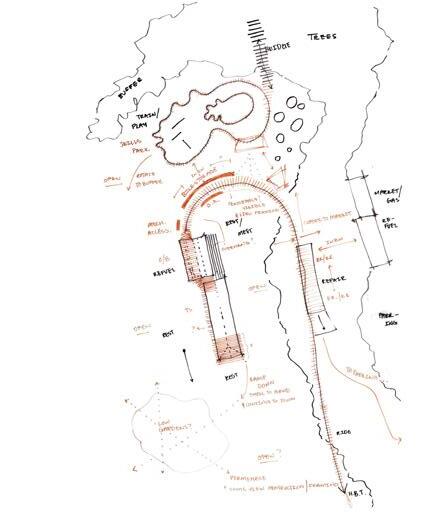














A Two-person Project Rehabilitating New York City’s Only Public Cemetery
Project Type Studio Date Location New Skills Public Architecture + Landscape Architecture
Shugars’ 4th Year Integrative Lab, Virginia Tech
Spring 2023 - Ongoing
Hart Island, New York
Building Codes, Passive House Design, Historic Site Rehabilitation, ClimateConsultant, Large-scale Site Model-making + Group Organization
Hart Island is New York’s only public cemetery. Buried are the city’s indigent and unclaimed, as well as victims of our nation’s worst epidemics and pandemics, including yellow fever, AIDS, and COVID-19. For a time, the 130-acre island housed boys’ and girls’ reformatories, tuberculosis hospitals, insane asylums, rehabilitation centers, and a rotating cohort of inmates from nearby Rikers Island who were charged with burying the dead.
In recent years, stewardship of the island has transitioned from the Department of Corrections to the New York City Department of Parks and Recreation. In an effort to reincorporate this long-stigmatized island into modern day New York, students were tasked with developing an island-wide site strategy and four off-grid buildings (a museum, memorial, ferry terminal, and visitor center -- one of which is presented here), and proposing through those interventions what role the island should play within the urban fabric of New York.
Jennifer To and I developed a site strategy that aims to serve two groups -the families of the dead and the general public -- in a way that respects the island’s humble and complicated history and allows the island to continue to serve as an ecological haven for various wildlife.




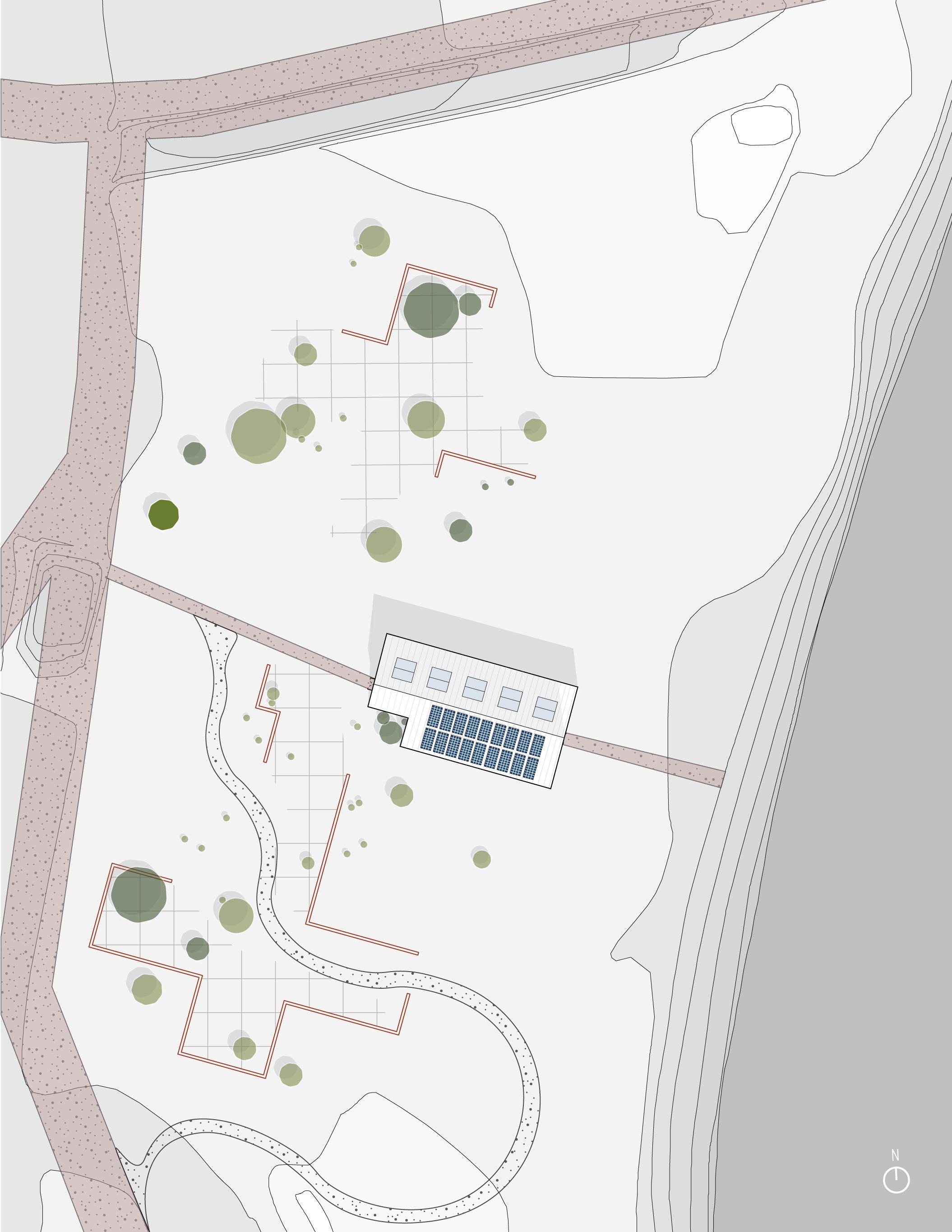


Foundation - Removed

Former Foundation - Reused

Existing Vegetation

Added Vegetation

The Museum is a hybrid between new construction and adaptive reuse. Because of the original building’s extensive collapse, only the remaining usable brick walls of the middle wing have been integrated into the new design.
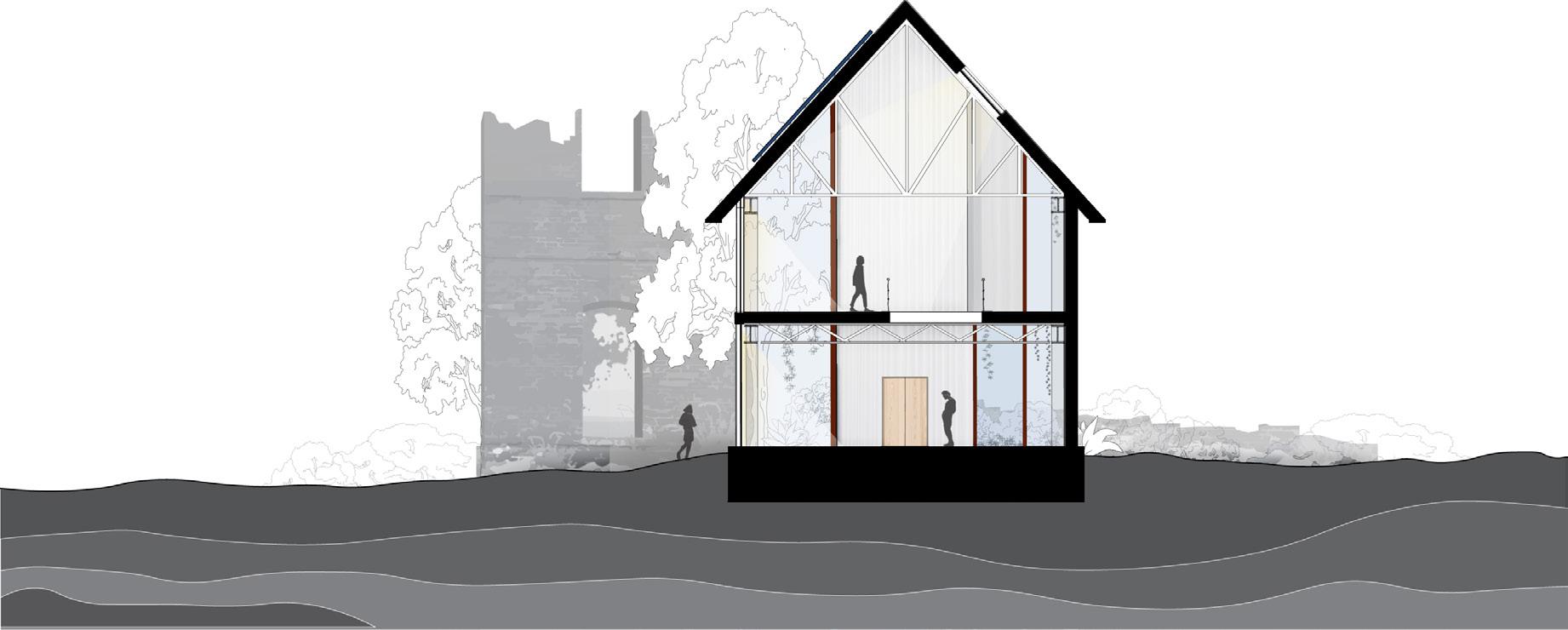
Much like the multi-layered and ambiguous history of Hart Island, the building employs the layering of materials and light to create different conditions of transparency and blur the lines between the interior and exterior.
The use of concrete slabs, open-web steel joists, steel girders, and columns allows for an open floor plan than can be adjusted by visiting artists using temporary hanging partitions to best suit their exhibits.
The new museum’s massing was informed by the old middle wing of the Phoenix House, which at one point housed a very successful rehabilitation program for addicts. The new construction is modeled after the exact proportions and dimensions of the Phoenix House, with some perimeter adjustments to retain the overgrowth of vegetation that developed after it’s abandonment. A handful of other House ruins will remain lining the perimeter of the building as part of a history and nature walking path connecting the island.
The orientation (East-West elongation) and overall dimensions of the building lend themselves to the use of photovoltaics for power generation and roof catchment for rainwater collection. Because the entire island is off-grid, both the water and power systems have to be addressed on a building-to-building basis. The museum uses constructed wetlands for black and greywater treatment, which will visually blend in to the re-vegetated natural wetlands surrounding the site. To conserve energy, the museum employs Passive House standards both in the schematic design and MEP design (continuing this semester). Strategies include thermal massing in the walls and floors, as well as optimallyplaced windows and skylights for daylight and ventilation.




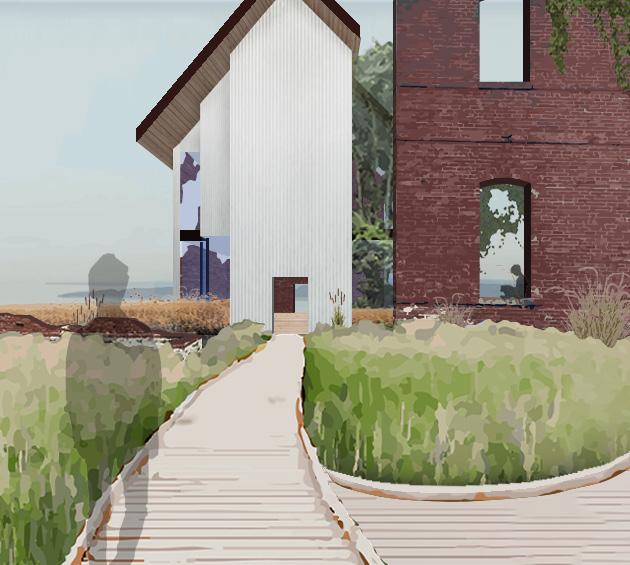

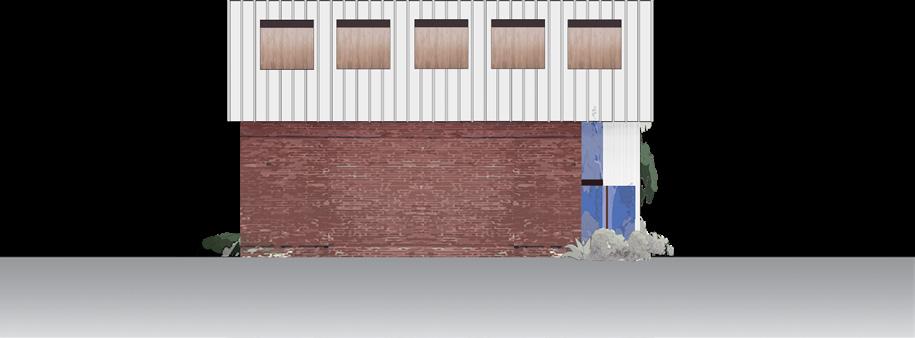
Found Objects: Analyses, Collages, Hand-Made Models
Project Type
Studio Date
Location New Skills Research
Garcia-Frankowski 2nd Year Studio, Virginia Tech
Fall 2020 N/A
Architecture Model-Making, Rhino 6, Photoshop, InDesign, Illustrator
This exploration of pure forms culminated in a series of multi-media case studies and re-imaginations of existing works of art and architecture. ‘Polyform’ was chosen out of a list including ‘Mat-building’, ‘Organs without a Body’, ‘Architecton’, and ‘Loop’, among others. Through a series of workshops and personal research, I developed a collection of polyformal samples and conveyed their qualities through line-drawings, collages, and physical models.
Polyforms were of particular interest to me because of their complex geometries, which I eagerly combined with my Rhino and Grasshopper skills to develop unfolding templates for a hybrid model-making process.
Polyform (n.) A solid or planar structure comprised of multiple, identical, geometric components, which may themselves be polyforms. A structure whose components are dissimilar but join or intersect in a loosely geometric or tessellated way such that the structure achieves a geometric or rigid appearance.
Studying and breaking these reference polyforms down into their geometric units allowed me to reverse-engineer their kit of parts and, later, redesign their forms. These case studies allowed us to become class experts in our respective forms and share our research and processes with each other.













Left Page (Top to Bottom)
Iterations of truncated & stellated icosahedron developed in Rhino
Grasshopper-generated unfolded templates for icosahedron physical model assembly
Modeled & Photographed GIF stages of additional polyform case studies
Right Page (Top to Bottom)
Left Synagogue in the Negev Desert, Zvi Hecker Line Drawing Collage Physical Model Replica
Right ‘Heart of Gold’, HYBYCOZO Line Drawing Collage Modified Physical Model


















Workshops for Other Worlds Architecture & Urban Planning Project
Project Type Studio Date
New Skills Commercial Architecture, Landscape Architecture, Urban Planning Garcia-Frankowski 2nd Year Studio, Virginia Tech Spring 2021 N/A
Location
Landscape Arch., Model-Making, Premiere Pro, AutoCAD, Grasshopper
One of the six polyform case studies, the stellated and truncated icosahedron, became the massing inspiration for an artists’ workshop and teaching studio. The workshop and neighboring urban park area in the Education District are located on a hypothetical campus alongside other students’ works.
Students were each given three plots of land to design -- one for their building and two for outdoor development -- and worked together to integrate their plots into a cohesive urban scheme.

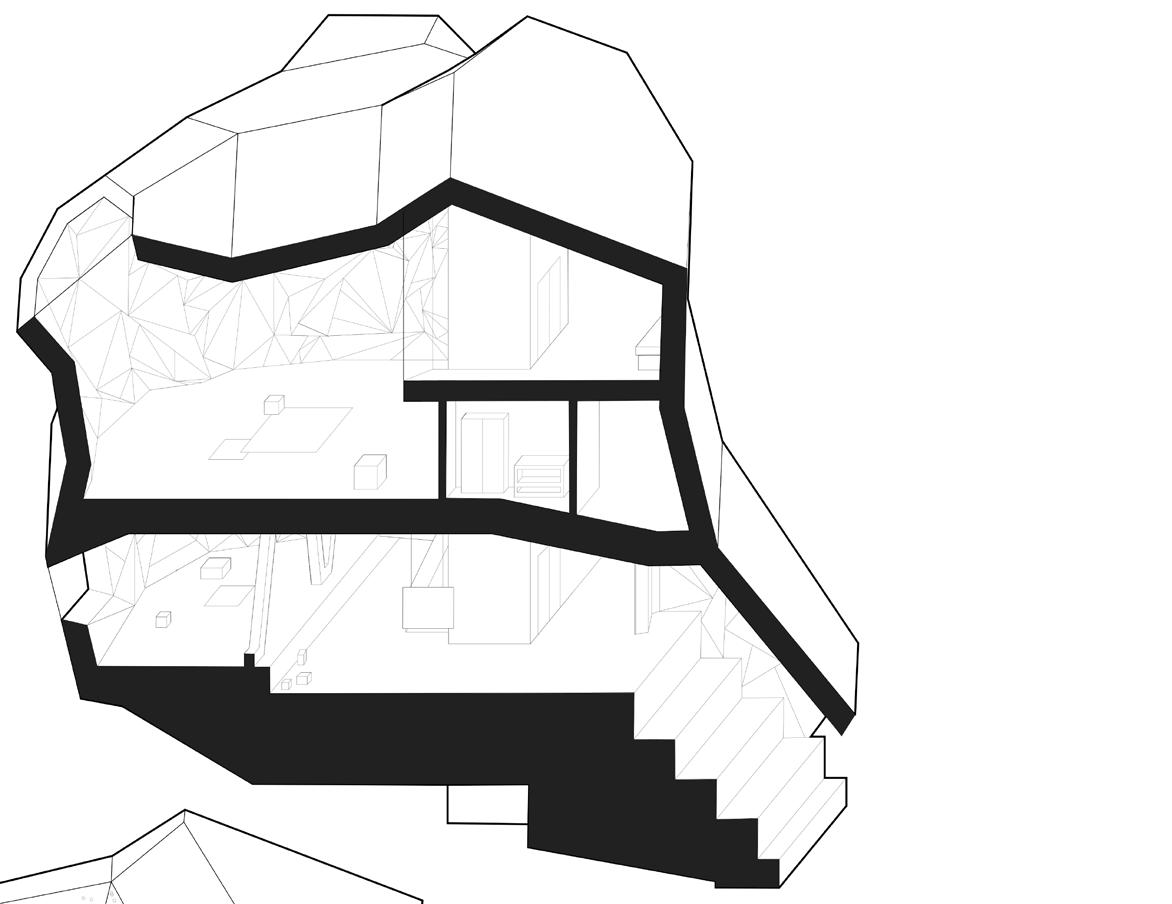

Before beginning the design process, each student selected a contemporary artist to design for. I chose Mark Bradford, whose work using everyday materials and collage as social commentary seemed well-suited to the intentions of our campus.
Using the modified ‘Heart of Gold’ from the Fall Semester I designed a studio, teaching space, student lounge, and exhibition space for Bradford and his students. The palette of Bradford’s works inspired the material selection for the building, and the large open spaces for production and exhibition lend themselves to Bradford’s large-scale works and process.


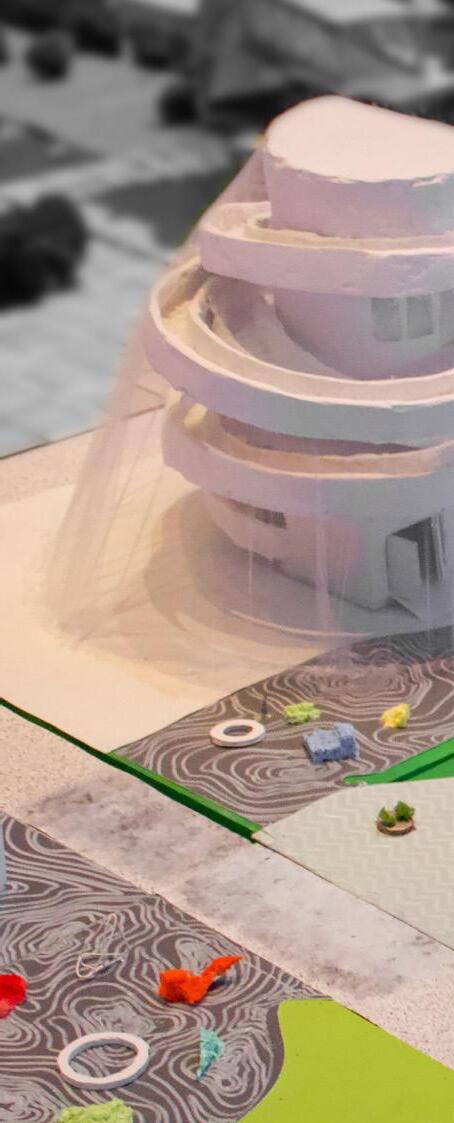

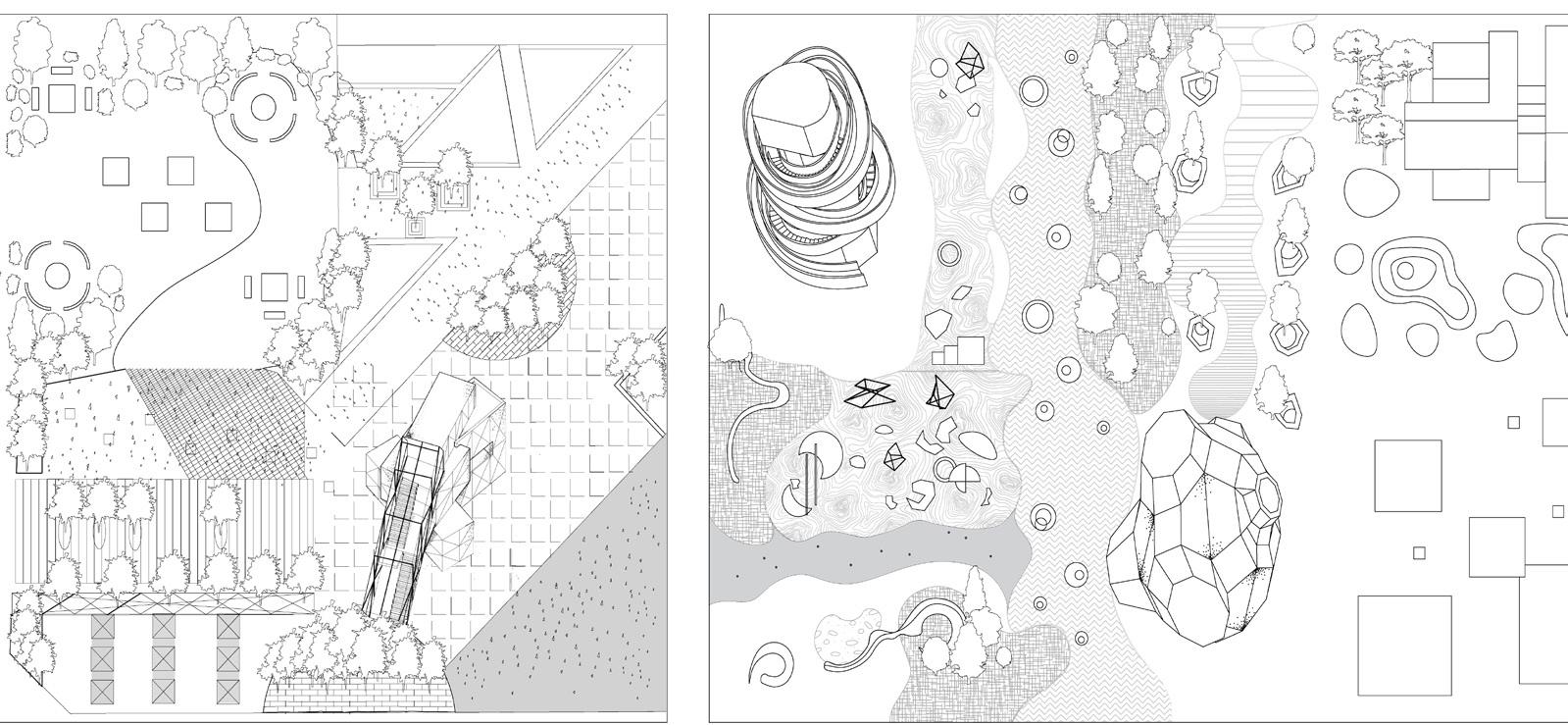
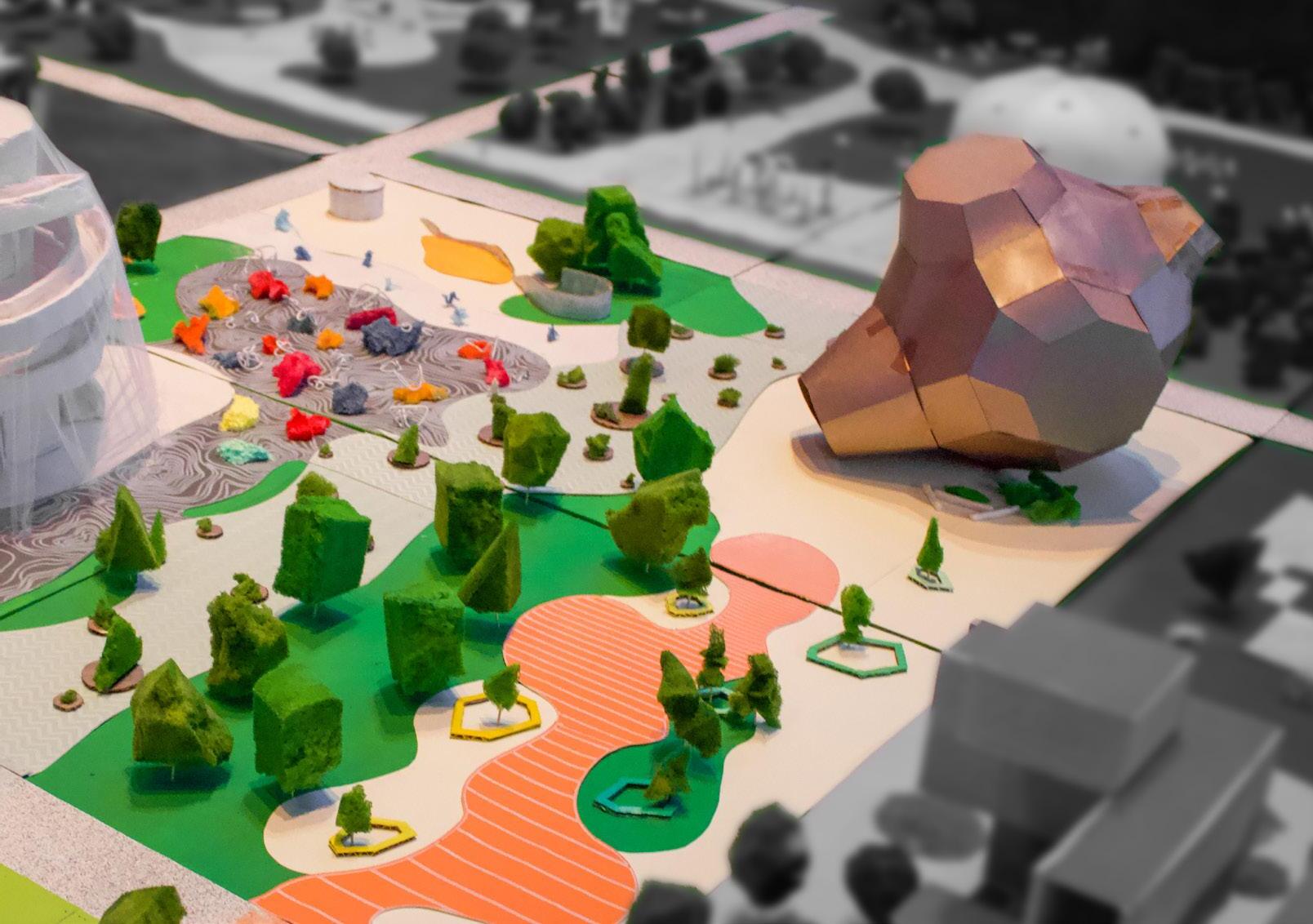
The landscape strategy for the Workshop was divided into three zones: Group, Individual, and Play. The Play zone included an outdoor playground and interactive water feature, which were shared with my neighbor (the white building in the image above), and centrally located between both buildings. The Group zone featured group seating elements and extended from the Workshop to the street, with the Individual zone located alongside it past an acoustically and visually insulating shared green space. The entry stair leading up into the lobby serves as shaded seating for performances in front of the building and also serves as the nexus for these three zones.

Self-Directed Gap Year Experience
Project Type
Studio Date Location
New Skills Residential Design + Build N/A 2018-2019
Falls Church, Virginia
Small-Scale Construction, Budgeting, Fundraising, Plan-Drawing
I took a gap year after graduating high school to crowdfund, research, design, build, and donate a grid-connectible mobile tiny house. This project gave me the opportunity to explore my budding architectural interests before committing to architecture school and I developed some invaluable skills in the process.
I managed a $20,000 budget, developed materials lists, and sourced and coordinated special orders (most notably, a composting toilet). I sought advice from local industry professionals including contractors, plumbers, and electricians, but otherwise taught myself.



The tiny house proposed a shed-style roof structure sloping away from the trailer hitch to concentrate the load at the front of the trailer bed. The wood-stud structure was designed to withstand high winds using Simpson Strong-Ties at critical stud and joist connections, while the loft on the tall end of the house maximizes usable space and provides lateral bracing.
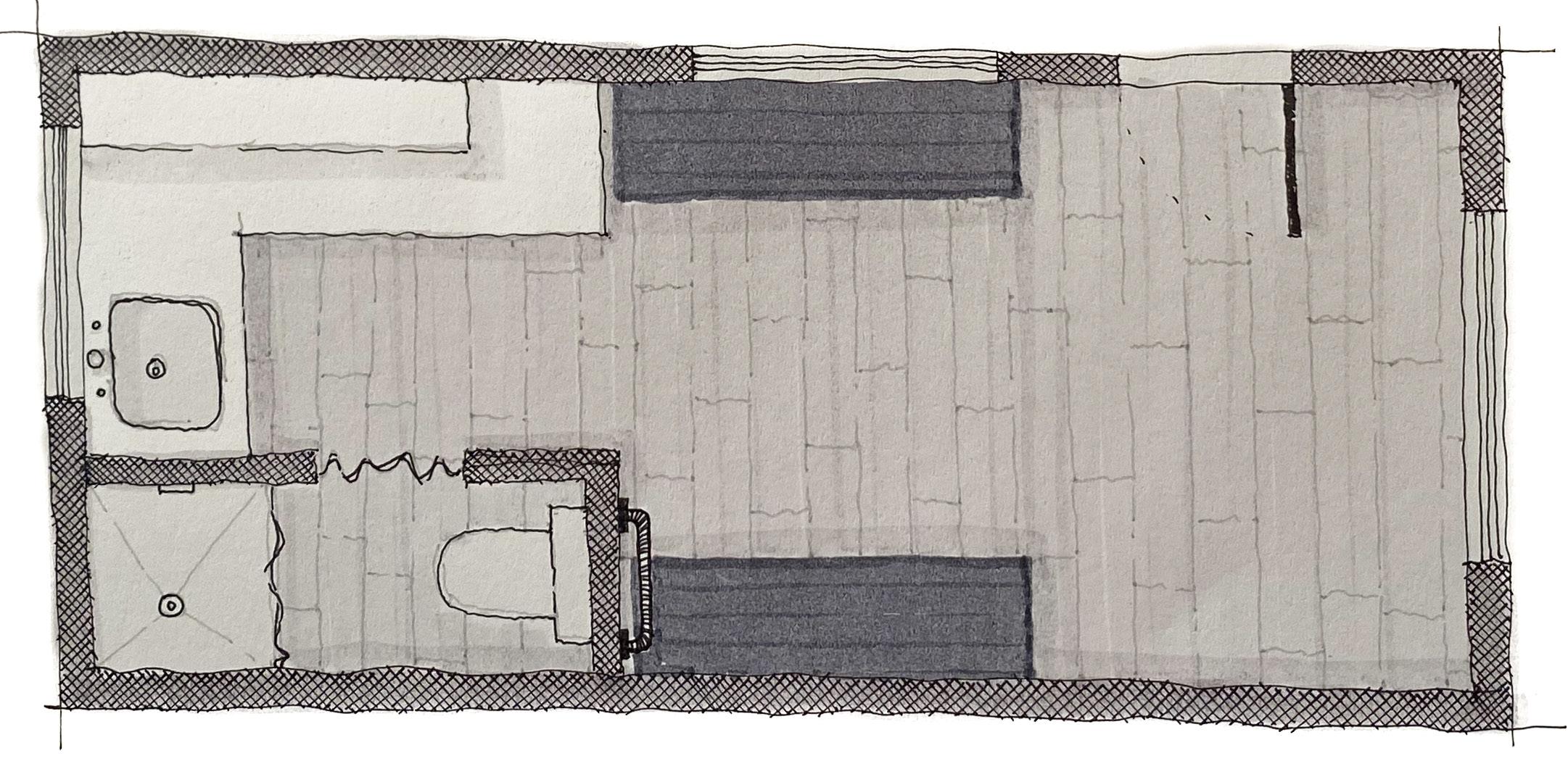


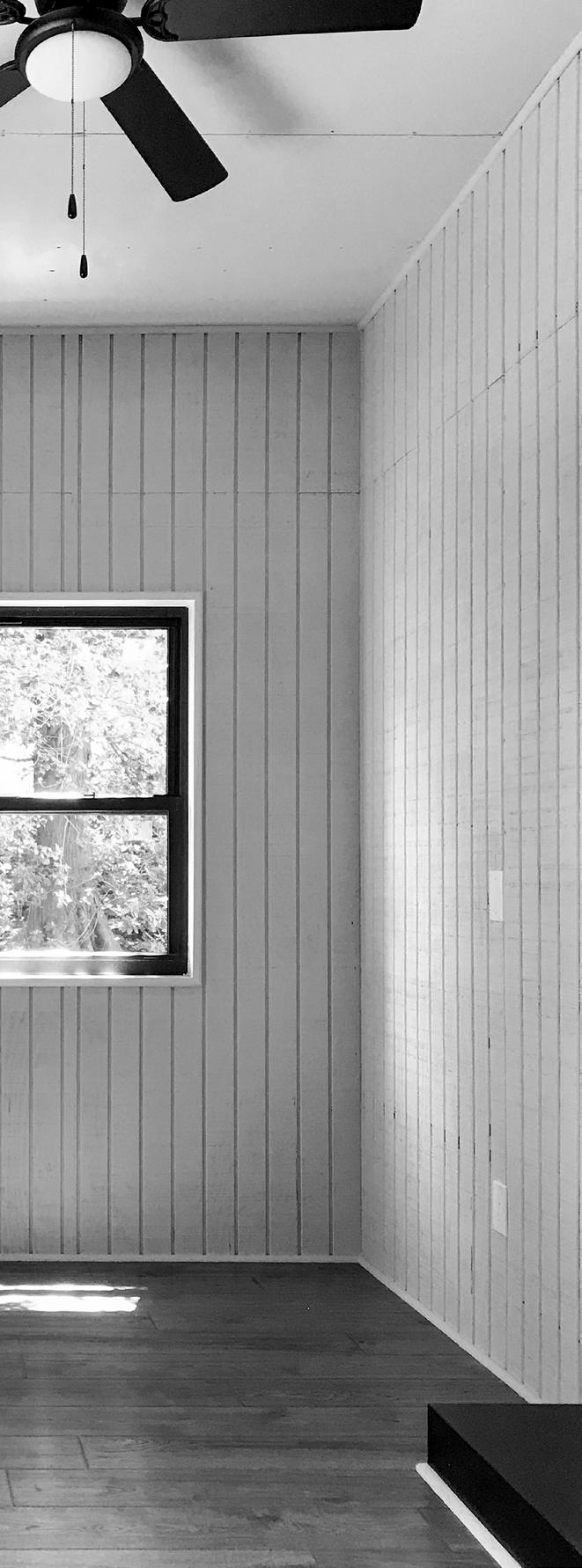
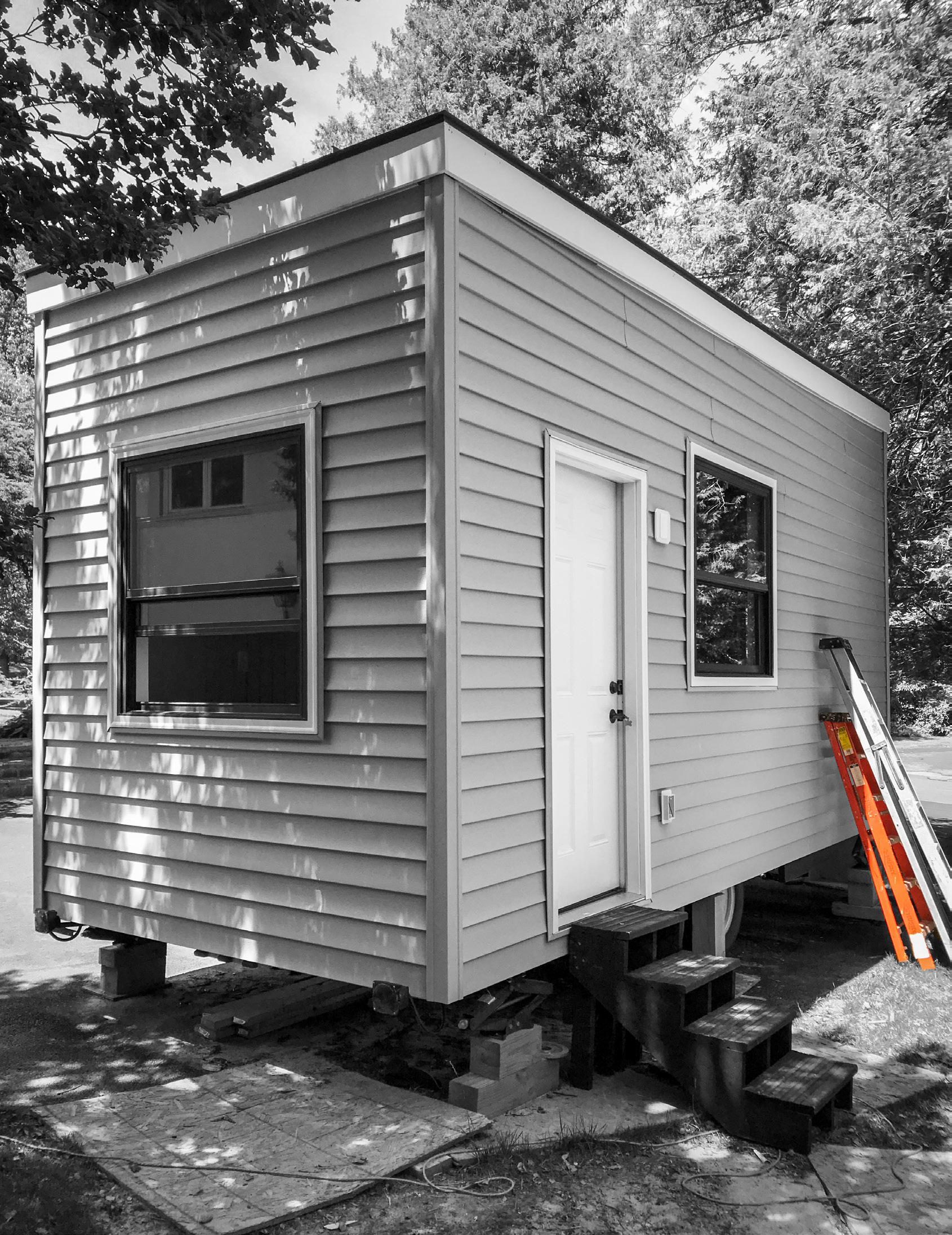
Prototyping Research Thesis
Project Type
Studio Date Location New Skills Industrial Design; Prototyping Prototyping Research Lab 2017-2018
Thomas Jefferson High School for Science and Technology Woodworking, CNC Machining, Metalworking, Fusion360, Electronics
This year-long senior research project explored and tested the balance between manual craft and digital fabrication at the scale of a tenor electric ukulele. The findings of the project concluded that digital fabrication was best suited for largeformat operations like cutting and boring, while sanding, finishing, and carving were best executed manually.
This ukulele played as accurately as a mid-range tenor electric ukulele, though it weighed considerably more due to its solid body (made of black walnut).

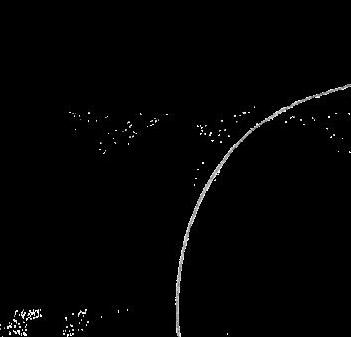
Bridge, Strings & Tuning Pegs
Manually Installed

Fretboard
CNC Routed
Hand Carved - Frets
Hand Sanded
Manually Installed
CNC Routed
Hand Carved - Housing
Hand Sanded
Manually Installed
